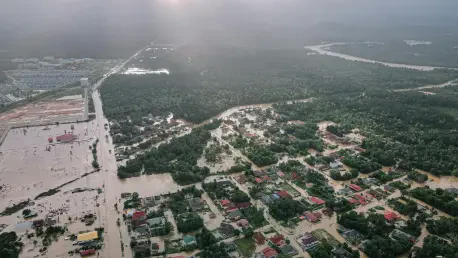In a striking reflection of the unpredictable nature of weather-related challenges facing the insurance industry, Allstate Corp., one of the leading personal lines insurers in the United States, has disclosed pretax catastrophe losses amounting to $213 million for August. This figure, while significant, represents a notable decrease from the $272 million reported for the same month in the previous year, offering a glimpse of temporary financial relief amidst ongoing volatility. Stemming from 10 distinct weather events, with roughly 70% of the losses tied to three major wind-and-hail storms, this report underscores the persistent impact of severe weather on insurer earnings. As climate-driven events continue to escalate in frequency and intensity, the stakes remain high for companies like Allstate, which must balance immediate financial pressures with long-term strategic growth. This scenario sets the stage for a deeper exploration of how such losses shape the broader landscape of property and casualty insurance.
Weather Impacts and Financial Implications
The $213 million in catastrophe losses reported by Allstate for August, though lower than the prior year’s $272 million across 15 events, still highlights the significant toll that weather-related incidents can take on the insurance sector. Notably, the absence of a landfalling hurricane this season has contributed to a reduced total of $397 million in losses for the first two months of the third quarter, nearly half of what was recorded in the same period previously. This decline may provide a temporary cushion for Allstate’s underwriting results, potentially easing the strain of escalating reinsurance costs that burden the industry at large. However, analysts remain cautious, pointing out that the lack of a major hurricane so far leaves the company exposed to potential late-season disruptions. The unpredictability of such events continues to challenge financial forecasting, as even a single severe storm could swiftly erase any gains achieved during quieter months, keeping insurers on edge.
Beyond the immediate numbers, the broader implications of these losses reveal a troubling trend of increasing severity and frequency of severe convective storms across the United States. Industry estimates suggest that August storm losses could reach hundreds of millions of dollars, with regions like the north-central U.S. and Chicago bearing the brunt of the impact. For Allstate, navigating this volatile landscape requires not only robust financial reserves but also adaptive strategies to mitigate risks associated with climate-driven weather patterns. The company’s ability to weather these challenges—both literally and figuratively—depends on its capacity to anticipate and respond to such events, even as the costs of claims and reinsurance continue to climb. This situation reflects a critical tension within the sector, where short-term relief must be weighed against the looming threat of future catastrophes that could reshape financial stability in an instant.
Market Position and Strategic Growth
Despite the financial pressures posed by catastrophe losses, Allstate has demonstrated resilience through sustained growth in its property and casualty portfolio. In August, the company reported a 0.9% year-over-year increase in protection policies in force, with auto policies rising by 1% and homeowners policies climbing by 2.1%. This expansion signals a strong market presence, positioning Allstate as a dominant player with an 8.96% share in homeowners multi-peril coverage—ranking second in the industry—and a 10.2% share in private passenger auto, placing it fourth behind major competitors. Such growth amidst claims challenges illustrates a strategic focus on expanding the policy base, which could serve as a buffer against the volatility of weather-related losses. The ability to maintain customer trust and attract new policyholders in this environment speaks to the company’s operational strength and adaptability.
Further reinforcing this narrative of resilience, Allstate’s financial stability is reflected in the varied ratings of its operating companies, ranging from superior to fair as assessed by industry benchmarks. This spectrum of ratings underscores a solid yet nuanced foundation, capable of supporting continued growth even as external pressures mount. The company’s stock price, recently recorded at $206.20 with a 4.54% uptick, also suggests investor confidence in its ability to navigate these turbulent waters. However, the persistent threat of escalating storm severity and the associated rise in claims costs remain critical hurdles. Balancing policy expansion with the financial realities of an increasingly unpredictable climate landscape will be essential for sustaining this momentum, as Allstate and its peers grapple with an era where earnings volatility has become the norm rather than the exception.
Navigating Future Uncertainties
Looking back, Allstate’s report of $213 million in August catastrophe losses marked a moment of relative reprieve compared to the heavier burden of the previous year. The absence of a major hurricane provided a brief window of financial breathing room, yet it also served as a reminder of the fragility of such gains in the face of potential late-season weather events. The company’s ability to grow its policy base during this period was a testament to its strategic foresight, even as industry-wide challenges like rising reinsurance costs and storm severity loomed large. Reflecting on these dynamics, it became clear that adaptability was key to weathering both literal and figurative storms.
Moving forward, the focus for Allstate and similar insurers should center on enhancing risk mitigation strategies, such as investing in advanced predictive models to better anticipate severe weather patterns. Strengthening partnerships with reinsurance providers to manage cost pressures could also prove vital. Additionally, continuing to build a robust policy portfolio will help diversify risk exposure. As the industry braces for the ongoing impacts of climate change, proactive measures to bolster resilience will be crucial in safeguarding financial stability against the unpredictable forces of nature.









